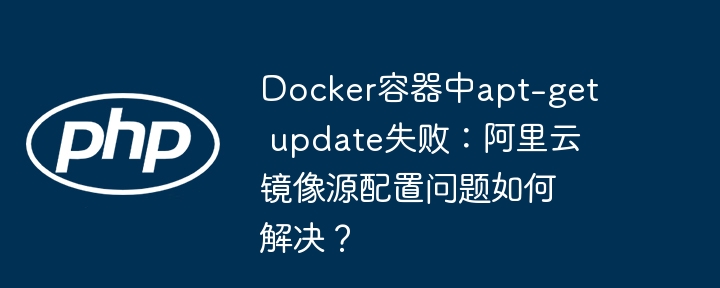 Backend Development
Backend Development
 PHP Tutorial
PHP Tutorial
 Apt-get update failed in Docker container: How to solve the problem of Alibaba Cloud's image source configuration?
Apt-get update failed in Docker container: How to solve the problem of Alibaba Cloud's image source configuration?
Apt-get update failed in Docker container: How to solve the problem of Alibaba Cloud's image source configuration?

apt-get update failed in Docker container: Detailed explanation of Alibaba Cloud image source configuration and solution
This article analyzes the problem that the apt-get update command fails after modifying the /etc/apt/sources.list file when using the official PHP 5.6-fpm image. The user tried to use the Alibaba Cloud image, but encountered errors such as "release file missing" and "url redirection target contains control characters".
The problem stems from the user directly replacing all sources in the /etc/apt/sources.list file, using the following Alibaba Cloud image configuration:
<code>deb http://mirrors.aliyun.com/debian/ stretch main non-free contrib deb-src http://mirrors.aliyun.com/debian/ stretch main non-free contrib deb http://mirrors.aliyun.com/debian-security stretch/updates main deb-src http://mirrors.aliyun.com/debian-security stretch/updates main deb http://mirrors.aliyun.com/debian/ stretch-updates main non-free contrib deb-src http://mirrors.aliyun.com/debian/ stretch-updates main non-free contrib</code>
This causes apt-get update to fail, prompting the release file missing, and URL redirection issues. The root cause is that the PHP 5.6-fpm image is based on older Debian systems (stretch, Debian 9), which no longer supports all the components listed in the user configuration.
The correct solution: Avoid completely replacing the source and only replacing the official Debian source as Alibaba Cloud image. Use the following command to execute in a new container:
sed -i 's/deb.debian.org/mirrors.aliyun.com/;s/security.debian.org/mirrors.aliyun.com/' /etc/apt/sources.list
This command replaces all addresses pointing to deb.debian.org and security.debian.org in the /etc/apt/sources.list file with Alibaba Cloud mirrors mirrors.aliyun.com , thereby solving the compatibility issue and ensuring that apt-get update is successfully executed. Be sure to do this in a new container to ensure the modification takes effect.
The above is the detailed content of Apt-get update failed in Docker container: How to solve the problem of Alibaba Cloud's image source configuration?. For more information, please follow other related articles on the PHP Chinese website!

Hot AI Tools

Undresser.AI Undress
AI-powered app for creating realistic nude photos

AI Clothes Remover
Online AI tool for removing clothes from photos.

Undress AI Tool
Undress images for free

Clothoff.io
AI clothes remover

AI Hentai Generator
Generate AI Hentai for free.

Hot Article

Hot Tools

Notepad++7.3.1
Easy-to-use and free code editor

SublimeText3 Chinese version
Chinese version, very easy to use

Zend Studio 13.0.1
Powerful PHP integrated development environment

Dreamweaver CS6
Visual web development tools

SublimeText3 Mac version
God-level code editing software (SublimeText3)

Hot Topics
 1382
1382
 52
52
 How to read the docker version
Apr 15, 2025 am 11:51 AM
How to read the docker version
Apr 15, 2025 am 11:51 AM
To get the Docker version, you can perform the following steps: Run the Docker command "docker --version" to view the client and server versions. For Mac or Windows, you can also view version information through the Version tab of the Docker Desktop GUI or the About Docker Desktop menu.
 How to create a mirror in docker
Apr 15, 2025 am 11:27 AM
How to create a mirror in docker
Apr 15, 2025 am 11:27 AM
Steps to create a Docker image: Write a Dockerfile that contains the build instructions. Build the image in the terminal, using the docker build command. Tag the image and assign names and tags using the docker tag command.
 How to use docker desktop
Apr 15, 2025 am 11:45 AM
How to use docker desktop
Apr 15, 2025 am 11:45 AM
How to use Docker Desktop? Docker Desktop is a tool for running Docker containers on local machines. The steps to use include: 1. Install Docker Desktop; 2. Start Docker Desktop; 3. Create Docker image (using Dockerfile); 4. Build Docker image (using docker build); 5. Run Docker container (using docker run).
 How to change the docker image source in China
Apr 15, 2025 am 11:30 AM
How to change the docker image source in China
Apr 15, 2025 am 11:30 AM
You can switch to the domestic mirror source. The steps are as follows: 1. Edit the configuration file /etc/docker/daemon.json and add the mirror source address; 2. After saving and exiting, restart the Docker service sudo systemctl restart docker to improve the image download speed and stability.
 How to check the name of the docker container
Apr 15, 2025 pm 12:21 PM
How to check the name of the docker container
Apr 15, 2025 pm 12:21 PM
You can query the Docker container name by following the steps: List all containers (docker ps). Filter the container list (using the grep command). Gets the container name (located in the "NAMES" column).
 How to view logs from docker
Apr 15, 2025 pm 12:24 PM
How to view logs from docker
Apr 15, 2025 pm 12:24 PM
The methods to view Docker logs include: using the docker logs command, for example: docker logs CONTAINER_NAME Use the docker exec command to run /bin/sh and view the log file, for example: docker exec -it CONTAINER_NAME /bin/sh ; cat /var/log/CONTAINER_NAME.log Use the docker-compose logs command of Docker Compose, for example: docker-compose -f docker-com
 How to build a private repository by docker
Apr 15, 2025 am 11:06 AM
How to build a private repository by docker
Apr 15, 2025 am 11:06 AM
You can build Docker private repositories to securely store and manage container images, providing strict control and security. The steps include: creating a repository, granting access, deploying a repository, pushing an image, and pulling an image. Advantages include security, version control, reduced network traffic and customization.
 How to update the image of docker
Apr 15, 2025 pm 12:03 PM
How to update the image of docker
Apr 15, 2025 pm 12:03 PM
The steps to update a Docker image are as follows: Pull the latest image tag New image Delete the old image for a specific tag (optional) Restart the container (if needed)



